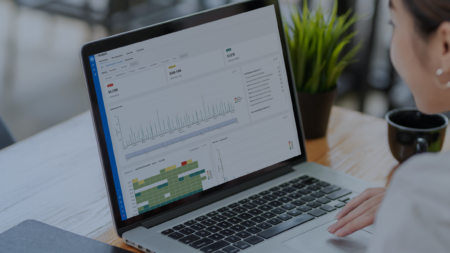Consistent financial reporting (CFR) gives enterprises a unified, defensible way to record and report data that stands up to audits, regulators, and internal stakeholders while unlocking insights that drive profitability and compliance.
As global compliance demands intensify — from IFRS to GAAP to SEC oversight — finance leaders are turning to smarter tools and stronger frameworks that include automation, standardization, and AI-driven reporting.
In this practical guide, we’ll walk through strategies and real-world examples to help your team master consistent financial reporting. We’ll cover everything from compliance frameworks to automation and answer key questions like “What does a financial report consist of?” along the way.
Clarify Regulatory Compliance and Internal Control Frameworks
To achieve consistency, fully understanding frameworks, like IFRS, U.S. GAAP, or both, is non-negotiable.
Falling short on compliance doesn’t just lead to mistakes and huge fines—compliance failures also cause reputational damage. While resources like Gov.uk focus narrowly on U.K. frameworks, a comprehensive grasp of PCAOB and SEC guidelines builds the trust modern enterprises need.
For many finance leaders, the challenge lies in maintaining financial reporting harmony while navigating risk and compliance obligations.
How CFR Can Help
With CFR, finance leaders and their teams can record, classify, and report on data consistently across the enterprise. No matter where or how information enters the system, it follows the same rules, undergoes identical controls, and tells the same financial story.
Proactive monitoring, reinforced with strong internal controls and clear reporting trails, creates alignment across departments and reduces surprises during reviews.
Example: Polaris
What would this look like in practice? Polaris, a leader in powersports vehicles, faced enterprise resource planning (ERP) fragmentation after multiple acquisitions.
To solve this issue, Polaris implemented AI-powered financial control, which helped it unify data across ledgers and find high-risk journal entries early. This meant Polaris’ audits went from simple compliance checkpoints to real year-round strengths.
Tip: Want to reinforce your internal controls? Explore our audit assurance solutions for dependable financial records to see how advanced controls can lock in accuracy and peace of mind.
Harness Technology for Data Quality and Automation
Once your frameworks are in place, the next move is embedding automation and AI-powered financial decision intelligence. This ensures continuous data accuracy, surfaces anomalies before they become material issues, and delivers insights CFOs and auditors can act on instantly.
Automated reporting systems reduce human error and bring efficiency to reconciliation, variance tracking, and compliance monitoring. To reduce inconsistencies, these tools flag anomalies, highlight trends, and enable timely decisions without waiting for month-end crunches.
Technology Integration Tips
When adopting AI-driven systems, implementing technology successfully is essential. Here are a few practical tips.
- Start with AI-powered tools that unify data across systems like ERP, customer relationship management (CRM), and billing platforms.
- Adopt risk scoring methodologies that automatically flag discrepancies. These are especially useful when aligning with IFRS-based materiality thresholds.
- Link systems via an end-to-end platform to streamline analytics, controls, and reporting. To learn more, explore our integrated financial analytics platform.
Example: Chevron
For instance, Chevron, a large energy company, found itself overwhelmed by billions of records across disparate systems. To fix this, it used MindBridge AI to analyze 30-40 million rows of data.
What previously took months, Chevron could now do in just a few days. Automation also helped auditors spot problematic transactions faster, uncovering insights that had once been impossible to find.
Audit teams may worry that automation will “replace” them. In reality, it’s the opposite, and Chevron’s example alone proves this. Automation handles the busywork, giving professionals more time for strategic risk assessments. In Chevron’s case, MindBridge transformed fragmented reporting into a centralized insights hub—proof that consistent financial reporting is about more than compliance, it’s about decision intelligence at enterprise scale.
Standardization and Risk Management
Consistency is about habits, not just controls or software. Risk-aligned, repeatable practices ensure that financial statements are audit-ready every day.
Bridging communication across departments can be stressful. Standardized templates, checklists, and workflows create clarity. They help cross-functional teams avoid redundant work and prevent those painful, last-minute reporting marathons.
Best Practices for Consistent Financial Reporting
Audits test both your numbers and processes. The most consistent financial reporting teams combine automation, standardized workflows, and explainable AI to ensure audit readiness every day—not just at year-end. These do’s and don’ts will help your team build that discipline into everyday operations, so nothing gets left to chance.
Do’s: What High-Performing Finance Teams Always Get Right
- Use consistent naming conventions. Standardize labels for accounts, reports, and processes to reduce confusion during audits and cross-functional reviews.
- Maintain a reporting-ready environment year-round. Store documentation, reconciliation, and approvals in centralized, accessible platforms.
- Rely on pre-approved templates and schedules. Use standard control templates, reporting checklists, and recurring timelines to streamline audits and ensure uniform execution.
- Track variances in real time. Embed variance analysis directly into monthly closes to flag anomalies early, not just at quarter-end.
- Document sign-offs across departments. Confirm that each department formally signs off on key financial reports to ensure accountability and reduce rework during audits.
Don’ts: How to Avoid Audit Risk
- Don’t rely solely on manual workflows. Manual tasks are error-prone and hard to scale. Automate recurring reconciliations, sign-off trails, and review processes wherever possible.
- Don’t skip variance analysis. Ignoring fluctuations between forecast and actuals can delay fraud detection or misstate financial health.
- Don’t overlook inter-department communication. Misalignment between finance, operations, and compliance leads to duplicated work and missed deadlines, especially during year-end close.
- Don’t recreate the wheel for every audit. Ad hoc reporting increases the risk of inconsistencies. Standardize your reporting formats and testing procedures early.
Example: Cherry Bekaert
Cherry Bekaert, a top U.S. accounting firm, implemented MindBridge across 25 offices to shift from traditional sampling to a risk-based, AI-supported audit approach.
By analyzing all financial transactions and using dynamic risk scoring, it reduced sample sizes by more than 30%, saving time and money without compromising quality.
Cherry Bakaert’s national rollout included policy development, staff training, and alignment with audit standards like SAS 142 and SAS 145, demonstrating how AI can drive both efficiency and compliance at scale.
Curious how top teams are using analytics to transform their audits? Dive deeper into performance analytics and auditing techniques.
Move Toward Consistent Financial Reporting
Effective financial reporting depends on strong processes, AI-powered technology, and a forward-thinking culture that values both compliance and profitability. With consistent financial reporting, finance leaders move beyond reactive compliance into proactive decision-making—detecting risks, recovering hidden margin, and building trust across the enterprise.
As Gartner’s insights on autonomous accounting show, leading chief financial officers are shifting away from ad hoc automation and toward strategic, high-impact AI use cases, especially those enhancing reporting consistency and decision-making.
Many leaders are using AI, analytics, and global frameworks to build audit-ready environments that scale. With tools like anomaly detection and ensemble AI, your financial reports can be accurate, insightful, efficient, and resilient.
Take the next step toward consistent financial operations and request a demo with MindBridge today.



